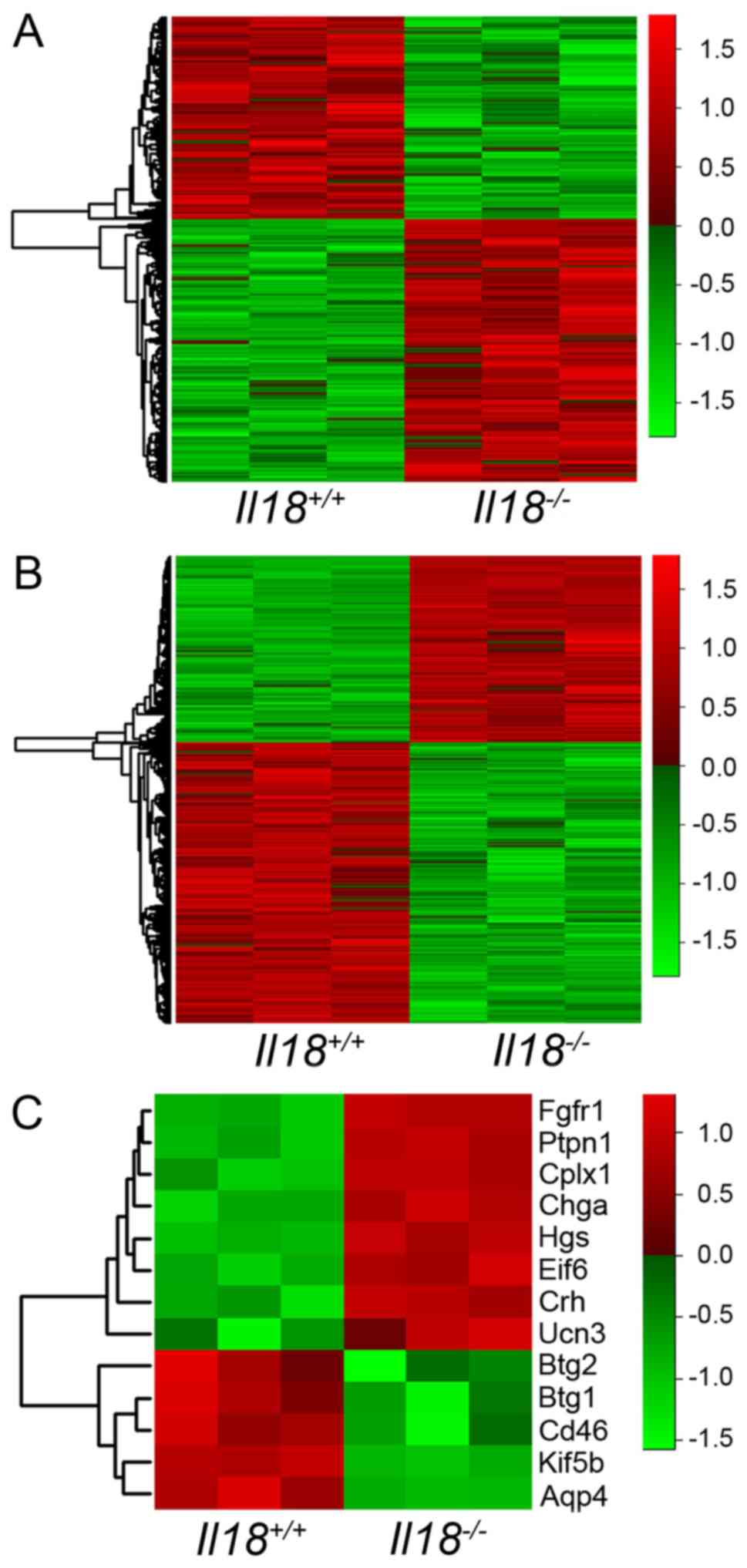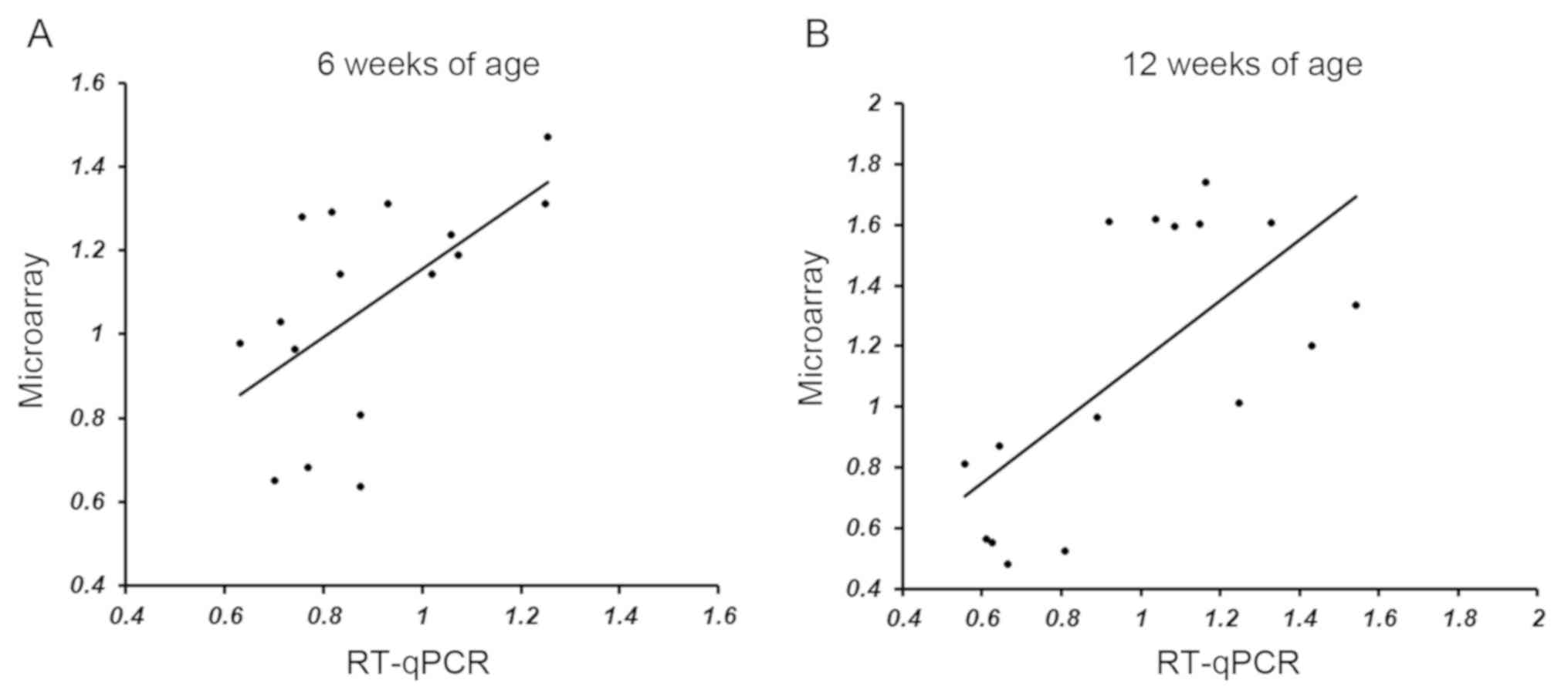|
1
|
Maes M: Major depression and activation of
the inflammatory response system. Adv Exp Med Biol. 461:25–46.
1999.PubMed/NCBI View Article : Google Scholar
|
|
2
|
Yirmiya R, Weidenfeld J, Pollak Y, Morag
M, Morag A, Avitsur R, Barak O, Reichenberg A, Cohen E, Shavit Y
and Ovadia H: Cytokines, ‘depression due to a general medical
condition’ and antidepressant drugs. Adv Exp Med Biol. 461:283–316.
1999.PubMed/NCBI View Article : Google Scholar
|
|
3
|
Dowlati Y, Herrmann N, Swardfager W, Liu
H, Sham L, Reim EK and Lanctôt KL: A meta-analysis of cytokines in
major depression. Biol Psychiatry. 67:446–457. 2010.PubMed/NCBI View Article : Google Scholar
|
|
4
|
Okamura H, Tsutsi H, Komatsu T, Yutsudo M,
Hakura A, Tanimoto T, Torigoe K, Okura T, Nukada Y, Hattori K, et
al: Cloning of a new cytokine that induces IFN-gamma production by
T cells. Nature. 378:88–91. 1995.PubMed/NCBI View Article : Google Scholar
|
|
5
|
Okamura H, Tsutsui H, Kashiwamura S,
Yoshimoto T and Nakanishi K: Interleukin-18: A novel cytokine that
augments both innate and acquired immunity. Adv Immunol.
70:281–312. 1998.PubMed/NCBI View Article : Google Scholar
|
|
6
|
Tsutsui H, Kayagaki N, Kuida K, Nakano H,
Hayashi N, Takeda K, Matsui K, Kashiwamura S, Hada T, Akira S, et
al: Caspase-1-independent, Fas/Fas ligand-mediated IL-18 secretion
from macrophages causes acute liver injury in mice. Immunity.
11:359–367. 1999.PubMed/NCBI View Article : Google Scholar
|
|
7
|
Ghayur T, Banerjee S, Hugunin M, Butler D,
Herzog L, Carter A, Quintal L, Sekut L, Talanian R, Paskind M, et
al: Caspase-1 processes IFN-gamma-inducing factor and regulates
LPS-induced IFN-gamma production. Nature. 386:619–623.
1997.PubMed/NCBI View Article : Google Scholar
|
|
8
|
Netea MG, Joosten LA, Lewis E, Jensen DR,
Voshol PJ, Kullberg BJ, Tack CJ, van Krieken H, Kim SH, Stalenhoef
AF, et al: Deficiency of interleukin-18 in mice leads to
hyperphagia, obesity and insulin resistance. Nat Med. 12:650–656.
2006.PubMed/NCBI View
Article : Google Scholar
|
|
9
|
Yamanishi K, Maeda S, Kuwahara-Otani S,
Watanabe Y, Yoshida M, Ikubo K, Okuzaki D, El-Darawish Y, Li W,
Nakasho K, et al: Interleukin-18-deficient mice develop
dyslipidemia resulting in nonalcoholic fatty liver disease and
steatohepatitis. Transl Res. 173:101–114.e7. 2016.PubMed/NCBI View Article : Google Scholar
|
|
10
|
Yamanishi K, Mukai K, Hashimoto T, Ikubo
K, Nakasho K, El-Darawish Y, Li W, Okuzaki D, Watanabe Y, Hayakawa
T, et al: Physiological and molecular effects of interleukin-18
administration on the mouse kidney. J Transl Med.
16(51)2018.PubMed/NCBI View Article : Google Scholar
|
|
11
|
Yamanishi K, Maeda S, Kuwahara-Otani S,
Hashimoto T, Ikubo K, Mukai K, Nakasho K, Gamachi N, El-Darawish Y,
Li W, et al: Deficiency in interleukin-18 promotes differentiation
of brown adipose tissue resulting in fat accumulation despite
dyslipidemia. J Transl Med. 16(314)2018.PubMed/NCBI View Article : Google Scholar
|
|
12
|
Yamanishi K, Doe N, Mukai K, Ikubo K,
Hashimoto T, Uwa N, Sumida M, El-Darawish Y, Gamachi N, Li W, et
al: Interleukin-18-deficient mice develop hippocampal abnormalities
related to possible depressive-like behaviors. Neuroscience.
408:147–160. 2019.PubMed/NCBI View Article : Google Scholar
|
|
13
|
Amat J, Baratta MV, Paul E, Bland ST,
Watkins LR and Maier SF: Medial prefrontal cortex determines how
stressor controllability affects behavior and dorsal raphe nucleus.
Nat Neurosci. 8:365–371. 2005.PubMed/NCBI View
Article : Google Scholar
|
|
14
|
Hamilton JP, Siemer M and Gotlib IH:
Amygdala volume in major depressive disorder: A meta-analysis of
magnetic resonance imaging studies. Mol Psychiatry. 13:993–1000.
2008.PubMed/NCBI View Article : Google Scholar
|
|
15
|
Yamanishi K, Doe N, Sumida M, Watanabe Y,
Yoshida M, Yamamoto H, Xu Y, Li W, Yamanishi H, Okamura H and
Matsunaga H: Hepatocyte nuclear factor 4 alpha is a key factor
related to depression and physiological homeostasis in the mouse
brain. PLoS One. 10(e0119021)2015.PubMed/NCBI View Article : Google Scholar
|
|
16
|
Ikubo K, Yamanishi K, Doe N, Hashimoto T,
Sumida M, Watanabe Y, El-Darawish Y, Li W, Okamura H, Yamanishi H
and Matsunaga H: Molecular analysis of the mouse brain exposed to
chronic mild stress: The influence of hepatocyte nuclear factor 4α
on physiological homeostasis. Mol Med Rep. 16:301–309.
2017.PubMed/NCBI View Article : Google Scholar
|
|
17
|
Yoshida M, Watanabe Y, Yamanishi K,
Yamashita A, Yamamoto H, Okuzaki D, Shimada K, Nojima H, Yasunaga
T, Okamura H, et al: Analysis of genes causing hypertension and
stroke in spontaneously hypertensive rats: Gene expression profiles
in the brain. Int J Mol Med. 33:887–896. 2014.PubMed/NCBI View Article : Google Scholar
|
|
18
|
Takeda K, Tsutsui H, Yoshimoto T, Adachi
O, Yoshida N, Kishimoto T, Okamura H, Nakanishi K and Akira S:
Defective NK cell activity and Th1 response in IL-18-deficient
mice. Immunity. 8:383–390. 1998.PubMed/NCBI View Article : Google Scholar
|
|
19
|
Tochigi M, Iwamoto K, Bundo M, Sasaki T,
Kato N and Kato T: Gene expression profiling of major depression
and suicide in the prefrontal cortex of postmortem brains. Neurosci
Res. 60:184–191. 2008.PubMed/NCBI View Article : Google Scholar
|
|
20
|
Tezval H, Jahn O, Todorovic C, Sasse A,
Eckart K and Spiess J: Cortagine, a specific agonist of
corticotropin-releasing factor receptor subtype 1, is anxiogenic
and antidepressive in the mouse model. Proc Natl Acad Sci USA.
101:9468–9473. 2004.PubMed/NCBI View Article : Google Scholar
|
|
21
|
Kang HJ, Adams DH, Simen A, Simen BB,
Rajkowska G, Stockmeier CA, Overholser JC, Meltzer HY, Jurjus GJ,
Konick LC, et al: Gene expression profiling in postmortem
prefrontal cortex of major depressive disorder. J Neurosci.
27:13329–13340. 2007.PubMed/NCBI View Article : Google Scholar
|
|
22
|
Tashiro E, Maruki H, Minato Y, Doki Y,
Weinstein IB and Imoto M: Overexpression of cyclin D1 contributes
to malignancy by up-regulation of fibroblast growth factor receptor
1 via the pRB/E2F pathway. Cancer Res. 63:424–431. 2003.PubMed/NCBI
|
|
23
|
Mahadev K, Motoshima H, Wu X, Ruddy JM,
Arnold RS, Cheng G, Lambeth JD and Goldstein BJ: The NAD(P)H
oxidase homolog Nox4 modulates insulin-stimulated generation of
H2O2 and plays an integral role in insulin signal transduction. Mol
Cell Biol. 24:1844–1854. 2004.PubMed/NCBI View Article : Google Scholar
|
|
24
|
Trokovic R, Trokovic N, Hernesniemi S,
Pirvola U, Vogt Weisenhorn DM, Rossant J, McMahon AP, Wurst W and
Partanen J: FGFR1 is independently required in both developing mid-
and hindbrain for sustained response to isthmic signals. EMBO J.
22:1811–1823. 2003.PubMed/NCBI View Article : Google Scholar
|
|
25
|
Stevens HE, Smith KM, Maragnoli ME, Fagel
D, Borok E, Shanabrough M, Horvath TL and Vaccarino FM: Fgfr2 is
required for the development of the medial prefrontal cortex and
its connections with limbic circuits. J Neurosci. 30:5590–5602.
2010.PubMed/NCBI View Article : Google Scholar
|
|
26
|
Elchebly M, Payette P, Michaliszyn E,
Cromlish W, Collins S, Loy AL, Normandin D, Cheng A, Himms-Hagen J,
Chan CC, et al: Increased insulin sensitivity and obesity
resistance in mice lacking the protein tyrosine phosphatase-1B
gene. Science. 283:1544–1548. 1999.PubMed/NCBI View Article : Google Scholar
|
|
27
|
Kuperman Y, Issler O, Regev L, Musseri I,
Navon I, Neufeld-Cohen A, Gil S and Chen A: Perifornical
Urocortin-3 mediates the link between stress-induced anxiety and
energy homeostasis. Proc Natl Acad Sci USA. 107:8393–8398.
2010.PubMed/NCBI View Article : Google Scholar
|
|
28
|
Li C, Chen P, Vaughan J, Lee KF and Vale
W: Urocortin 3 regulates glucose-stimulated insulin secretion and
energy homeostasis. Proc Natl Acad Sci USA. 104:4206–4211.
2007.PubMed/NCBI View Article : Google Scholar
|
|
29
|
Kasukawa T, Masumoto KH, Nikaido I, Nagano
M, Uno KD, Tsujino K, Hanashima C, Shigeyoshi Y and Ueda H:
Quantitative expression profile of distinct functional regions in
the adult mouse brain. PLoS One. 6(e23228)2011.PubMed/NCBI View Article : Google Scholar
|
|
30
|
Sawada K, Young CE, Barr AM, Longworth K,
Takahashi S, Arango V, Mann JJ, Dwork AJ, Falkai P, Phillips AG and
Honer WG: Altered immunoreactivity of complexin protein in
prefrontal cortex in severe mental illness. Mol Psychiatry.
7:484–492. 2002.PubMed/NCBI View Article : Google Scholar
|
|
31
|
Chen G, Wang J, Liu Z and Kornmann M: Exon
III splicing of fibroblast growth factor receptor 1 is modulated by
growth factors and cyclin D1. Pancreas. 37:159–164. 2008.PubMed/NCBI View Article : Google Scholar
|
|
32
|
Fortress AM, Schram SL, Tuscher JJ and
Frick KM: Canonical Wnt signaling is necessary for object
recognition memory consolidation. J Neurosci. 33:12619–12626.
2013.PubMed/NCBI View Article : Google Scholar
|
|
33
|
Hui J, Zhang J, Pu M, Zhou X, Dong L, Mao
X, Shi G, Zou J, Wu J, Jiang D and Xi G: Modulation of
GSK-3β/β-catenin signaling contributes to learning and memory
impairment in a rat model of depression. Int J
Neuropsychopharmacol. 21:858–870. 2018.PubMed/NCBI View Article : Google Scholar
|
|
34
|
Yu L, Haverty PM, Mariani J, Wang Y, Shen
HY, Schwarzschild MA, Weng Z and Chen JF: Genetic and
pharmacological inactivation of adenosine A2A receptor reveals an
Egr-2-mediated transcriptional regulatory network in the mouse
striatum. Physiol Genomics. 23:89–102. 2005.PubMed/NCBI View Article : Google Scholar
|
|
35
|
Krishnadas R and Cavanagh J: Depression:
An inflammatory illness? J Neurol Neurosurg Psychiatry. 83:495–502.
2012.PubMed/NCBI View Article : Google Scholar
|
|
36
|
Khairova RA, Machado-Vieira R, Du J and
Manji HK: A potential role for pro-inflammatory cytokines in
regulating synaptic plasticity in major depressive disorder. Int J
Neuropsychopharmacol. 12:561–578. 2009.PubMed/NCBI View Article : Google Scholar
|
|
37
|
Liu H, Luiten PG, Eisel UL, Dejongste MJ
and Schoemaker RG: Depression after myocardial infarction:
TNF-α-induced alterations of the blood-brain barrier and its
putative therapeutic implications. Neurosci Biobehav Rev.
37:561–572. 2013.PubMed/NCBI View Article : Google Scholar
|
|
38
|
Yamamoto M, Guo DH, Hernandez CM and
Stranahan AM: Endothelial Adora2a activation promotes blood-brain
barrier breakdown and cognitive impairment in mice with
diet-induced insulin resistance. J Neurosci. 39:4179–4192.
2019.PubMed/NCBI View Article : Google Scholar
|

















